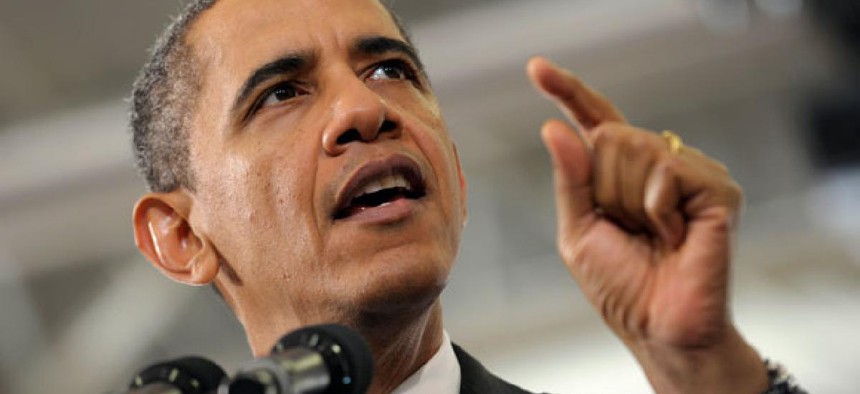
Susan Walsh/AP
Tough road to a debt deal, even for a community-organizer-in-chief
Deal-making in a deeply divided Congress requires negotiating with party leaders in the House and Senate.
President Obama’s reelection campaign managed to community-organize its way to electoral victory and a second term. Now we'll find out whether the same kind of grassroots approach can help Obama push his policy agenda through a divided Congress. Rallying voters behind a candidate is one thing; it’s quite another to rally citizens behind a plan to reduce the deficit and avert end-of-year spending cuts and tax increases, and then translate that support into legislative action.
“I’d be hard pressed to find out how those -- which are very useful skills -- in a direct way benefit a bargain,” Norman Ornstein, resident scholar at the American Enterprise Institute, said of organizing a group of citizens behind a common goal.
Deal-making in a deeply divided Congress requires negotiating with party leaders in the House and Senate. Sweet-talking moderates can go only so far, Ornstein said. And Republican leaders who hold their own power and leverage aren’t likely to be cowed by calls to their offices from angry Obama supporters.
“Part of it is, are you going to be able to get, say, McConnell to step aside while 40 senators from both sides work out a bargain?” Ornstein said of Senate Minority Leader Mitch McConnell, R-Ky. Persuading House Speaker John Boehner, R-Ohio, to call a vote on a deal unpopular with his caucus -- as any bipartisan agreement is sure to be -- is another challenge.
Obama is already planning to head out across the country to rally the public behind his insistence that a deal include both higher taxes on the wealthy and spending cuts, The New York Times reported on Monday. The president also plans to maintain his grassroots organization to leverage public support, according to The Times. Last cycle, vestiges of Obama’s 2008 field organization were incorporated into the Democratic National Committee to further Democratic policy goals.
The White House, and the president himself, have long touted the benefits of playing an outside game. Senior adviser David Plouffe told reporters last week that Obama’s supporters “play a very, very important role” in policy change, citing health reform and student loans as two examples. Obama believes “you’re not going to be able to change Washington solely from the inside,” Plouffe said.
It’s hard to prove, however, that pressure applied by Obama’s supporters managed to move legislators during his first term. As the president approaches his second, the pitched battle over deficit reduction may be a particularly difficult space for him to leverage his grassroots organization.
“To mobilize people out there, there needs to be a kind of clarity,” said Marshall Ganz, senior lecturer in public policy at Harvard's John F. Kennedy School of Government. It’s extremely hard to mobilize people behind a plan that doesn’t yet exist, or is in the process of being tweaked and disputed by legislators. When it came to health care reform, for example, “the president’s own objectives were murky,” Ganz said, which may have made mobilizing his supporters more challenging.
It’s also hard for citizens to feel like writing to their members of Congress actually makes a difference. “I think one of the general challenges is that individual citizens have a much less direct role in the legislative process,” said Sasha Issenberg, author of The Victory Lab: The Secret Science of Winning Campaigns.
Swaying individual legislators is less effective these days than it has been in the past, given how few moderates are left and how few members are willing to buck the party leadership, said John Hudak of the Brookings Institution.
To “go public” and try to build support for a given policy is seen by many political scientists as a president’s last resort, Hudak added. If a president has to go to the people, it’s usually because he’s not getting much traction on Capitol Hill.
A bully-pulpit strategy would be most effective once legislators reach a bipartisan framework -- not while they’re working toward one, Ornstein said. If a plan emerges, Obama should “immediately endorse it, bring everybody to the White House, praise it, praise them, and then go to the public,” Ornstein added, noting that building public support could help give Boehner the cover he needs to call a vote in the House.
Obama’s data-driven campaign may give him another advantage. The Obama machine “knows what is happening within individual congressional districts, and what voters want, and what voters are thinking about, and what turnout is like,” Hudak said.
“If there is new leverage that the permanent Obama machine has on Congress,” it’s raising the threat of defeat at the polls in 2014, Issenberg said.
On the campaign trail, Obama criticized his Republican opponent for touting a set of skills that may not be transferable to the White House. “If your main argument for how to grow the economy is, ‘I knew how to make a lot of money for investors,’ then you’re missing what this job is about,” Obama said in May when asked about his campaign’s attacks on Mitt Romney’s private equity record.
An ethos closer to Obama’s heart -- community organizing -- already exists in Washington. There are plenty of folks who spend their days going door to door, building a sense of collective purpose, knowing who to target and how to push their buttons.
“There are community organizers for Congress,” Issenberg said. “They’re called lobbyists.”
NEXT STORY: Advice to Obama: Make More Friends in Congress






